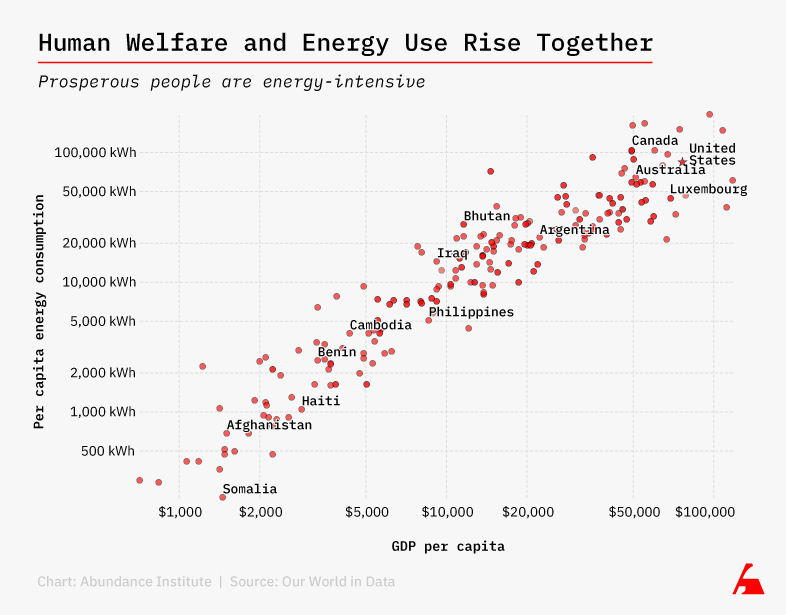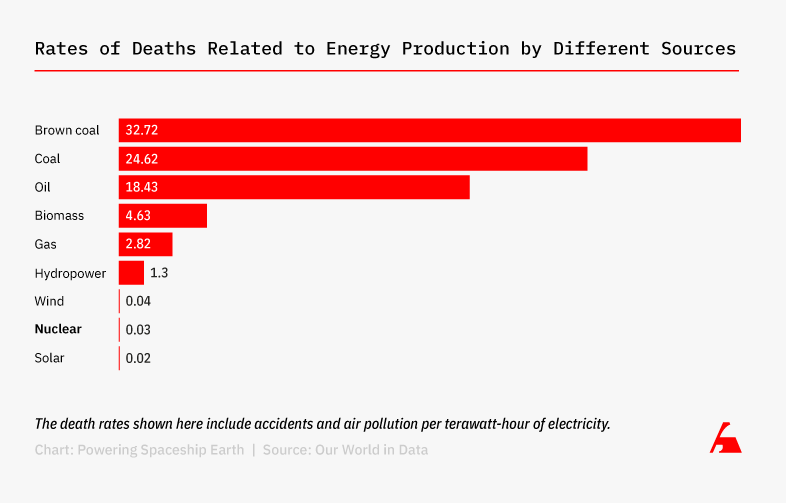Testimony before the House Oversight Committee
Subcommittee on Economic Growth, Energy Policy, and Regulatory Affairs
Hearing: The New Atomic Age: Advancing America’s Energy Future.
Chairman Burlison and Members of the Committee, thank you for the opportunity to testify. My name is Josh T. Smith, and I am the Energy Policy Lead for the Abundance Institute.
The Abundance Institute is a mission-driven nonprofit dedicated to creating the cultural and policy environment necessary for emerging technologies to thrive and drive widespread human prosperity.
My three core points to you today are:
Prosperity is energy-intensive.
Regulatory failures hold back the nuclear industry.
State policymakers are anxious to play a role in America’s new atomic age.
Prosperity is energy-intensive
America’s economic growth, technological progress, and improved quality of life all require more energy, not less. There is a clear relationship between energy use and wealth. Harnessing energy is both a cause and a consequence of rising living standards.

A world of energy abundance is a world of opportunity: for industry, for families, for national strength. Since the first reactors lit up within nuclear facilities, nuclear power has played a role in this story. Yet nuclear energy has yet to reach its full potential.
Regulatory failures hold back the nuclear industry
Every discussion of nuclear power’s future should start with a simple and incontrovertible historical fact: For decades, American engineers built nuclear plants swiftly, safely, and cheaply.
Connecticut Yankee, for example, was built for about $1 billion in today’s dollars and in about five years. This trio—swift, safe, and cheap—was the norm for decades.
Nuclear’s struggles today aren’t inherent to the technology. They are the product of outdated, unfit, and counterproductive regulations. Major problems that Congress must address are:
The combination of using Linear No-Threshold (LNT) models and the 'as low as reasonably achievable' (ALARA) principle creates an unending treadmill. Cost savings are eaten by ever more onerous safety requirements.
The NRC’s current regulatory regime is not suited for advanced or small modular reactors. Recent efforts to address this, including the 2019 Nuclear Energy Innovation and Modernization Act (NEIMA) and the Accelerating Deployment of Versatile, Advanced Nuclear for Clean Energy Act (ADVANCE) Act, have yet to yield meaningful results.
Policymaking and public conversations have become divorced from the real risks of nuclear energy. Instead of sensible and scientifically based precautions, we have almost entirely prohibited nuclear development in America.
LNT is an unfalsifiable and uneconomic standard
LNT models overlook the importance of radiation dosage. LNT assumes that any dose of ionizing radiation, no matter how small, has some potential to increase risks and that risk increases linearly with dose. The major outcome is the belief that there is no safe threshold. This makes little sense in practice. Radiation is all around us in everyday items and activities (e.g., granite countertops, bananas, smoke detectors, routine medical procedures, and flights). Just as with sunbathing, it is the dosage and timing that matter.
As Ted Nordhaus of the Breakthrough Institute recently quipped in an interview with the Wall Street Journal about LNT, “What is the public interest in regulating theoretical health exposures from which you literally can’t see any consequences, ever?”
LNT modeling does not account for this dosage timing and magnitude, and so prescribes mitigation efforts in excess of what would pass a cost-benefit test. In place of LNT, a better approach would be to adopt a model that suggests different responses based on the level of radiation exposure.
The NRC’s regulatory regime does not enable advanced or modular reactors
Congress has tried multiple times in the last three decades to enable new forms of nuclear energy and development. Just a few of these are:
Energy Policy Act of 1992 - combined construction and operation licenses to streamline regulatory processes.
Energy Policy Act of 2005 - allocated funds to insulate plants in construction from delays.
NEIMA (2019) - required the Nuclear Regulatory Commission to establish new rules for advanced reactors.
ADVANCE Act - the latest, passed in July 2024, was meant to simplify approval processes and speed reviews.
Each of these involves a collection of changes, and the ADVANCE Act is only one year old. Yet NEIMA is widely thought of as failing to encourage innovation in the U.S. nuclear industry. The licensing process was intended to establish a performance standard against which reactors could be judged. This was meant to replace the prescriptive standard laying out specific actions or technologies that must be used. Regulatory comments and discussions continue. Yet the best evidence of NEIMA’s failure so far is that it has failed to create the envisioned and intended surge of small modular reactor (SMR) companies or deployment of SMRs or advanced reactors. Congress must continue pushing the NRC to enable nuclear power with clear, definite, and risk-informed rules.
Policymaking and public conversations have become divorced from real risks
Radiation fears, waste concerns, and accident risks are all routinely overstated and used to justify rules that impose ever-higher costs without commensurate benefits. At root, the cost-benefit analysis of nuclear regulations is lacking. These misunderstandings drove increased regulations that ultimately made new nuclear uneconomic relative to other generation sources.
Policymaking is distracted by these exaggerated risks and worries. Policymakers should govern understanding that every energy source has risks and trade-offs. Per terawatt-hour (TWh) generated, nuclear power results in 0.03 deaths. That’s 800 times fewer deaths than from coal, after accounting for both accidents and pollution. Even natural gas, which burns much cleaner, is just short of 100 times deadlier than nuclear.

Nuclear power’s disasters loom over the industry. Three nuclear accidents shaped the public’s imagination. All three are misunderstood:
Fukushima: No one died from the reactor explosion or the nuclear release. Only one radiation-related death has been reported. The cleanup has gone well, and the natural background radiation in high-altitude places, like Colorado, is now higher than Fukushima’s background radiation.
Three Mile Island: No one died in the reactor failure, nor have radiation-related deaths been found. The other reactor continued operating until 2019, when it closed for economic reasons (and is now expected to come back online soon).
Chernobyl: A true disaster that was possible because the Soviet reactor’s design included positive feedback loops that allowed a runaway reaction when combined with operator error. Today’s reactors use negative feedback to shut themselves down in emergencies. Estimates vary, but it’s likely that between 4,000 and 16,000 people died. Every death was preventable.
Common concerns about nuclear waste are also overblown. Lawmakers should remember that all energy sources and uses entail some form of waste and byproducts. In the case of nuclear, however, the waste generated by electricity to serve one person during their life would be about the size of a soda can or a coffee cup. In addition, all the existing waste today from U.S. commercial reactors would not even fill a football field. As the Department of Energy explains:
U.S. commercial reactors have generated about 90,000 metric tons of spent fuel since the 1950s. If all of it were able to be stacked together, it could fit on a single football field at a depth of less than 10 yards.
Both of these figures are also even more optimistic given the opportunities for spent fuel to be recycled.
Nuclear power’s safety record is exceptional. New designs leverage additional passive safety improvements that prevent runaway reactions, or because they are smaller, pose lesser risks. So far, the NRC has failed to enable these reactors to grow and reach commercial operations.
It’s more than nuclear-specific rules preventing the new atomic age
Policymakers should also not forget the interconnected nature of many electricity policy challenges. Even with NRC reform, nuclear projects will be bogged down in the same transmission, interconnection, and permitting bottlenecks that stifle all large-scale infrastructure.
For example, it takes, on average, 10 years to build a transmission line, yet 7 of those years are paperwork. Interconnection timelines add years of delays as well. On interconnection, in particular, the restart of Three Mile Island by Constellation and Microsoft is illuminating. Governor Josh Shapiro intervened to request that the PJM grid operators expedite the reconnection of the reactor. As I wrote in the Wall Street Journal about the indisputable merits of the restart, “Only in broken systems does a project require a governor’s intervention to move forward.” The core lesson is that we need to streamline permitting and grid interconnection to ensure a reliable energy supply.
Fundamentally, nuclear plants can’t succeed in a system that blocks entry before shovels hit dirt. Free entry into the energy system is broken. Permitting, siting, interconnection, and transmission are all clogged arteries in need of reform alongside nuclear regulations. Your constituents pay higher energy costs because of all of these challenges.
State policymakers are anxious to play a role in America’s new atomic age
Finally, state lawmakers are ready and willing to play a larger role in America’s new atomic age. The National Conference of State Legislatures’ State Energy Legislation Database reports 254 bills related to nuclear energy and nuclear waste introduced in the 2025 legislative session.
Nuclear regulation has long had state-level connections. Multiple commissioners at the NRC have state-level regulatory experience in agencies or on public utility commissions. In addition, 39 states already participate in the Agreement State Program enabled by the Atomic Energy Act in 1954. When Connecticut completes the process, it will mark a full eight out of 10 states that participate. These agreements allow states to assume some of the NRC’s roles. As the NRC describes these programs:
Section 274 of the Act provides a statutory basis under which NRC relinquishes to the States portions of its regulatory authority to license and regulate byproduct materials (radioisotopes); source materials (uranium and thorium); and certain quantities of special nuclear materials. The mechanism for the transfer of NRC's authority to a State is an agreement signed by the Governor of the State and the Chairman of the Commission, in accordance with section 274b of the Act.
In addition to existing pathways like this, states are stepping up. Utah, Idaho, and Wyoming signed a memorandum of agreement in April of 2025 to investigate nuclear options together. This is indicative of just one way that states will share resources and collaborate if allowed to do so by future reforms.
State-level leadership is required for any new atomic age to thrive. In the past, governors and lawmakers played important roles as gatekeepers to their states. For example, Senator Harry Reid’s opposition to storing waste at Yucca Mountain continues to have reverberations for today’s nuclear waste policies. Massachusetts Governor Michael Dukakis opposed the start of the Seabrook plant in neighboring New Hampshire, adding at least three years of delay to the project. In 1990, the NRC had to order the plant to start even without Dukakis’s participation in emergency planning that they had otherwise required.
Today, governors and state legislators are leading the opposite charge–pushing to enable nuclear power in their states. State leaders in Utah, my home, including Governor Spencer Cox and members of the state legislature, are promoting nuclear development through public outreach and education about the opportunities the industry brings.
Ushering in the new atomic age requires tackling the misperceptions about nuclear power’s risks and its failing regulatory system. Returning to a world where nuclear power is swift, safe, and cheap is entirely possible.